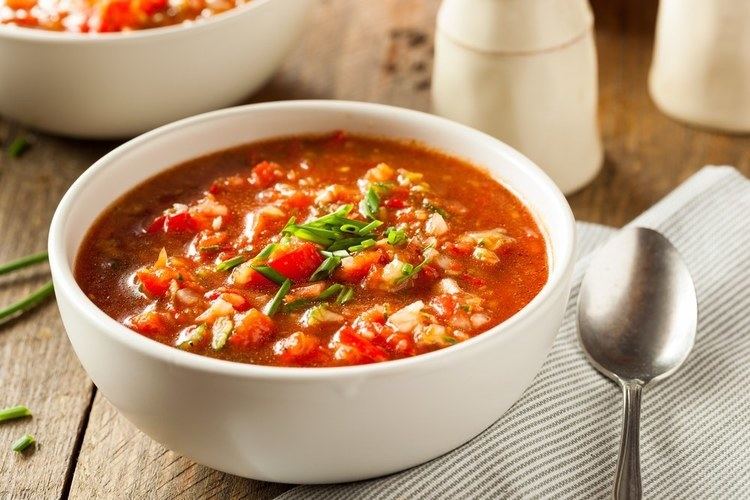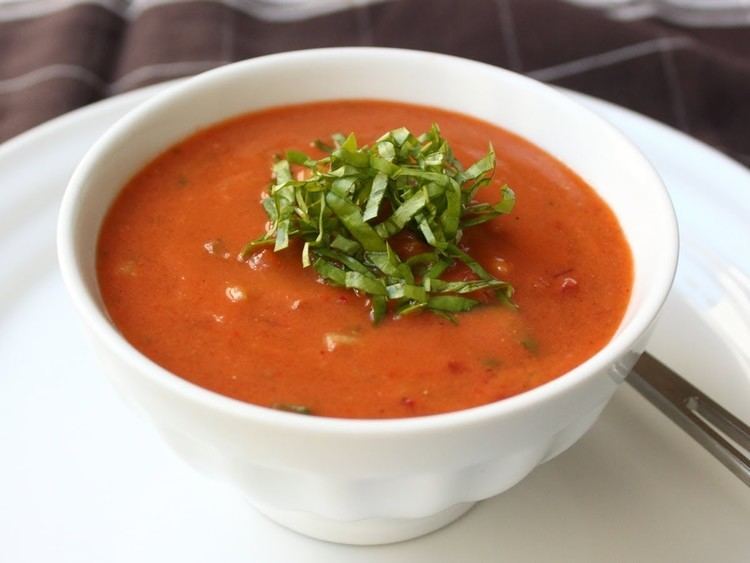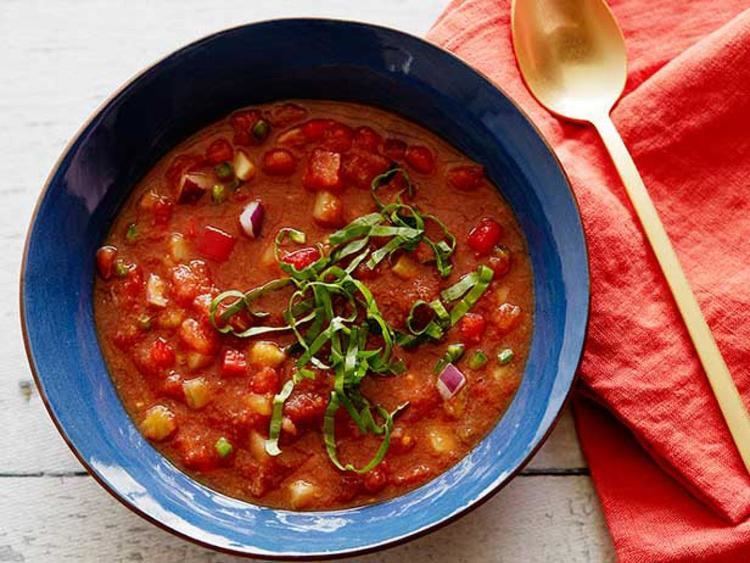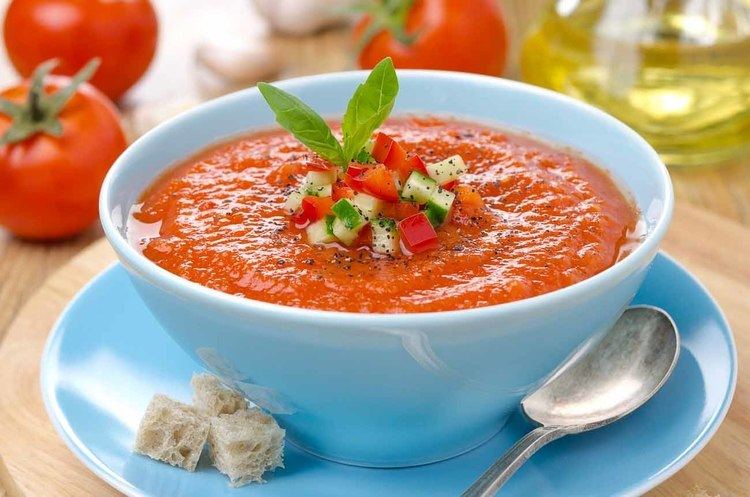Course Appetizer Variations Salmorejo Variation Saljo Main ingredients Tomato, Cucumber, Garlic | Serving temperature Cold Food energy(per serving) variable kcal | |
 | ||
Similar Tomato, Carpaccio, Paella, Saljo, Garlic | ||
Gazpacho recipe cold tomato cucumber pepper soup
Gazpacho ([ɡaθˈpatʃo]; [ɡaʰˈpːa(t)ʃo]) is a soup made of raw vegetables and served cold, originating in the southern Spanish region of Andalusia. Gazpacho is widely eaten in Spain and neighbouring Portugal ([ɡɐʃˈpaʃu], gaspacho), particularly during the hot summers, as it is refreshing and cool.
Contents
- Gazpacho recipe cold tomato cucumber pepper soup
- Spanish gazpacho soup omar allibhoy
- History
- Ingredients and preparation
- Variations
- In Spain
- Arranque roteo
- Extremaduran variations
- La Mancha variations
- Castilian variations
- In popular culture
- References

Spanish gazpacho soup omar allibhoy
History
Gazpacho has ancient roots. There are a number of theories of its origin, including as a soup of bread, olive oil, water and garlic that arrived in Spain and Portugal with the Romans and also with the addition of vinegar. Once in Spain, it became a part of Andalusian cuisine, particularly Córdoba and Seville, using stale bread, garlic, olive oil, salt, and vinegar, similar to ajoblanco.

During the 19th century, the red gazpacho evolved when tomatoes were added among the ingredients. This version was spread internationally.
There are many modern variations of gazpacho, often in different colors and omitting the tomatoes and bread in favor of avocados, cucumbers, parsley, watermelon, grapes, meat stock, seafood, and other ingredients.
Ingredients and preparation
In Andalusia, most gazpacho recipes typically include stale bread, tomato, cucumber, bell pepper, onion and garlic, olive oil, wine vinegar, water, and salt.
The following is a typical modern method of preparing gazpacho:

- The vegetables are washed and the tomatoes, garlic and onions are peeled.
- All the vegetables and herbs are chopped and put into a large container (alternatively, the tomatoes may be puréed in a blender or food processor, pounded in a mortar (the traditional method), or strained and de-seeded with a food mill)
- Some of the contents of the container are then blended until liquid, depending on the desired consistency.
- Chilled water, olive oil, vinegar and salt are then added to taste.
- The remaining contents of the container are added to the liquid, then briefly blended, but not to purée, leaving some texture. (optional)
- Garnishes may be made with fresh bell pepper slices, diced tomatoes and cucumber, or other fresh ingredients.
Traditionally, gazpacho was made by pounding the vegetables in a mortar with a pestle; this more laborious method is still sometimes used as it helps keep the gazpacho cool and avoids the foam and the completely smooth consistency created by blenders and food processors. A traditional way of preparation is to pound garlic cloves in a mortar, add a little soaked stale bread, then olive oil and salt, to make a paste. Then very ripe tomatoes and vinegar are added. In the days before refrigeration the gazpacho was left in an unglazed earthenware pot to cool by evaporation, and some water added.
Gazpacho may be served with garnishes, served separately, such as hard boiled eggs and chopped ham (in the salmorejo variety from Córdoba), chopped almonds, cumin crushed with mint, orange segments, finely chopped green pepper, onion, tomato or cucumber. In Extremadura, gazpacho with local ham, added to the gazpacho rather than as a garnish, is called gazpacho extremeño. Andalusian sources say that gazpacho should be slightly chilled, but not iced.
Variations
Ingredients, texture, and how thick the gazpacho is made vary regionally and between families.
Similar cold raw soups such as Arjamolho in Portugal, salmorejo, porra antequerana and ajoblanco, are also popular in Andalusia, although not as widespread as gazpacho.
Gazpacho manchego, despite its name, is a meat stew, served hot, not a variation on the cold vegetable soup.
In Spain
In the historical description of gazpacho it was remarked that the original recipe uses bread, water, vinegar, oil and salt. This recipe is very old in the Iberian Peninsula, going back to Roman times. Every Andalusian region or comarca has its own variety. The humble gazpacho became a very deeply rooted food for peasants and shepherds in the south of Spain. The basic gazpacho gave rise to many variants, some also called gazpacho, others not; some authors have tried to classify all these variations. Gazpachos may be classified by colour: the most usual red ones (which contain tomato), white ones (which contain no tomato, but include dried fruits), and green ones (which are white but contain some spices that make them green). These variants have their basic ingredients in common, garlic paste which works as an emulsifier, bread, olive oil, vinegar and salt. To the traditional ingredients red fruits such as strawberries, muskmelon, etc., may be added, making the gazpacho a bit sweeter. Gazpacho may be served as a starter, main dish, or tapa.
Arranque roteño
A popular variation comes from the town of Rota in the province of Cadiz. During times of drought there was not enough water to make gazpacho; arranque has the same ingredients as gazpacho, but uses less water and bread, making it a sort of cream. Some people add more bread until it takes on the consistency of a dip.
Extremaduran variations
In Extremadura, gazpachos are a kind of purée or thick gazpacho known as cojondongo, or cojondongo del gañán, made of breadcrumbs, garlics, oil, vinegar and on the top of that chopped onions, tomato and peppers.
La Mancha variations
Gazpacho manchego, as its name implies, is made in the east region of La Mancha, in Albacete and nearby areas, and is popular in other areas in the center and southwest of the country.
It is a meat stew, whose main ingredients are small game animals or birds such as rabbit, hare, quail, or pigeon and flat bread, and may include garlic, tomatoes, and mushrooms. It is cooked in a cauldron and served hot. Garlic and tomatoes may be added. Another well-known variant in La Mancha is gazpachos de pastor or galianos.
Some other hot meat or fish dishes from other regions are called gazpachos (gazpacho jumillano, gazpacho de Yecla, gazpacho de Requena, etc.).
Castilian variations
Gazpacho is often eaten during the very hot and dry summers in Castilla y León. The gazpacho made in La Moraña in the province of Ávila has large pieces of vegetables floating in a watery soup.
